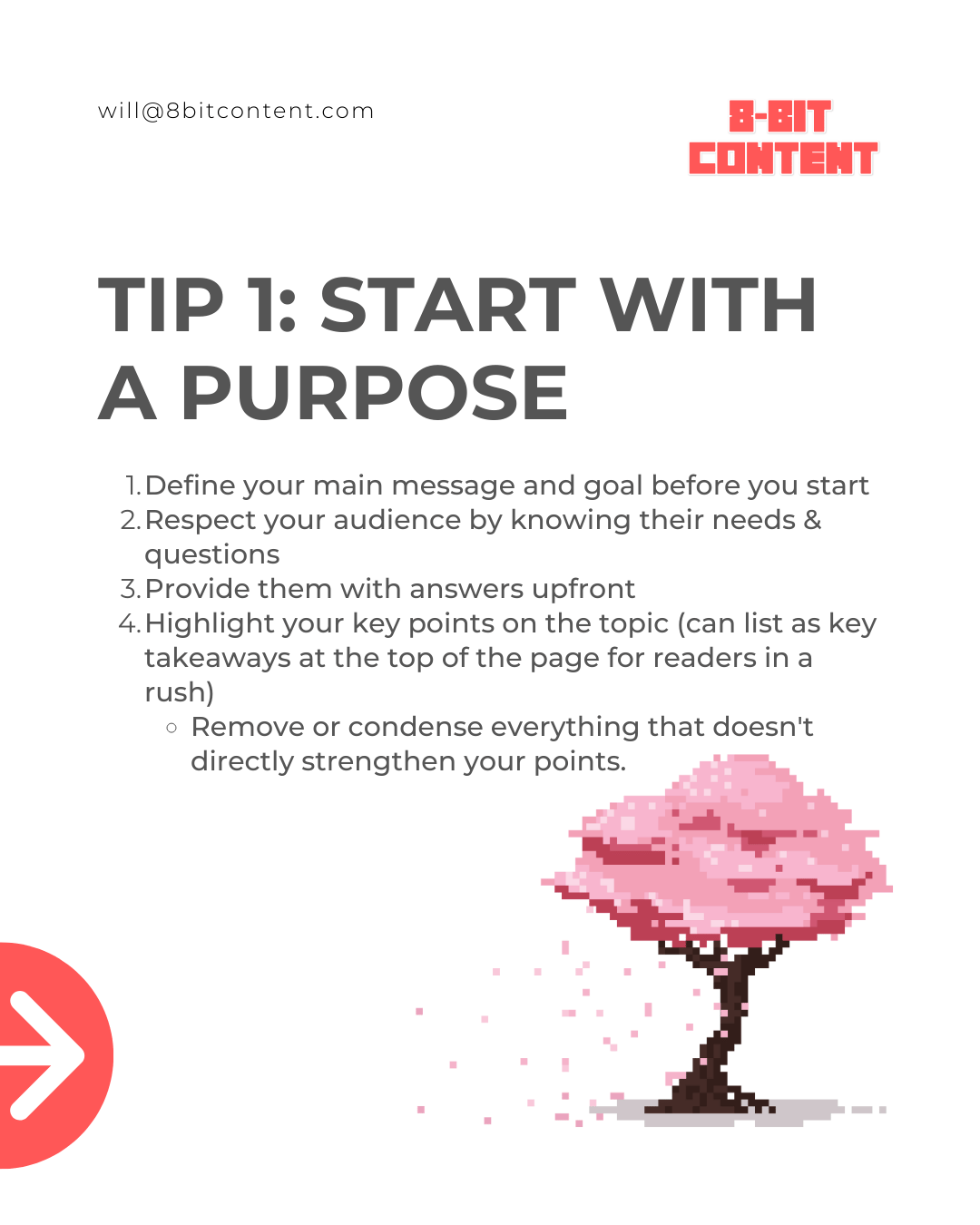How To Spot Fluff in Writing & 7 Simple Ways To Avoid It
All publishers and content creators share the same problem. Fluff in writing.
Content that takes too long to get to the point is wasteful.
Your desired readers will bounce off your page before you get to the actual point.
And so your time and energy will be for nothing.
So here's how to spot fluff in writing and what you can do to stop it.
(PLUS at the end we include a carousel with tips for creating fluff-free content regardless of format.)

What is Fluff in Writing?
Fluff is unnecessary and irrelevant content that adds zero value to readers. It can be long-winded descriptions, filler words, irrelevant facts, and whatever else is used to make content needlessly long.
You can find fluff in advertising copy and other marketing materials. And it's often used in an attempt to make products more appealing (perhaps thanks to the Length-Implies-Strength Heuristic from copywriting legend Gary Halbert).
But its often poorly used and abused, with no benefit.
Thankfully, with a strong understanding of fluff writing, after this article, you can ensure that your new and old (via updates) content is concise and meaningful.
Types of Fluff Writing and Common Causes
There's a wide range of fluff bloating up the internet.
There are fluffy words, sentences, sections, and even entire fluffy articles.
And there can be many factors to blame for this, such as:
- The common belief is that longer articles rank better and are shared more.
- The common practice of paying writers per word.
- A lack of experience and research on topics written by generalist writers following an SEO NLP tool like Surfer or Frase.
It all leads to useless filler, with surface-level details of meaningless generalities that scream AI writers.
Examples of Fluff Words?
Adverbs are often examples of common fluff.
For example, words like 'very' or 'really.'
They don't add any meaning, and Stephen King hates them.
There are also phrases like "in order to" (to) and "due to fact that" (because), which are unnecessary filler that can be removed or replaced with simpler versions - or better yet, if appropriate - power words.
Key Tips for Eliminating Fluff Writing
If you're in a rush, I want to give you some important tips I've learned from nearly 10 years in the business!
These are the most effective things anyone can do to combat fluff in your content:
- Start with a foundation of respect and understanding for your target reader.
- Plan out your content with an organized and logical outline.
- Aim to get your message across as quick and simple as possible.
- Use concrete, simple language with specific examples if helpful.
- Edit out platitudes, redundancies (unless it's a summarized section for those in a rush like this one ;), and anything else that won't help your readers.

7 Simple Ways to Avoid Fluff in Writing
So how to stop the madness that is filler content and get to the point?
Here are 7 easy ways:
1. Respect Your Reader
Respecting your target audience is key.
It will help avoid adding patronizing stuff that the reader already knows.
For example:
Let's say someone is searching 'how to measure the effectiveness of your content marketing efforts' in Google.
There's no good reason to start off explaining what content marketing is or why you need to measure its results.
If they're searching how, they're probably past the who what, when, where, why stages.
So, what's most important, when avoiding fluff writing is answering the reader's questions asap.
It'll lead to a better reader experience and help you avoid high bounce rates.
And to effectively do this, you must...
2. Create an Outline Before You Write
This is where you plan out what you want to say before you write.
It's essential for any writing you do, especially a blog post.
Meaningful content for readers and search engines require a clear, logical structure.
You can always copy the structure of the top-ranking pages for a topic.
'If it ain't broke don't fix it.'
But it'll be hard to outrank them unless you go the extra mile.
So checking people also ask questions, quora, reddit, and even YouTube for a given topic can help you add extra information your competitors maybe missed.
3. Target a Shorter Word Count
It's generally good practice to target a word count based on an average of the top ranking pages.
However, if your actual content can be shorter than average, great.
Sharp, concise writing will likely win in the long run.
And depending on the topic, you'll probably want shorter word lengths.
As briefly mentioned above, there was a while when bloggers thought they needed 3000 words to rank.
This was because Google's algorithm was less advanced and needed more words to understand pages.
But now, it's safe to say that Google's algorithm is highly advanced and needs far fewer words to do this.
And since we all have increasingly shorter attention spans, it's safe to bet that finding a wider audience to read long blog articles will continue to shrink.
Side Note: This isn't to suggest people will stop reading.
It's just that longer doesn't equal better.
And satisfying a searcher's intent as quickly as possible is what's important.

4. Be Specific
Abstract language and generalizations usually just make your writing fluffier.
Adding specifics and examples to what your content can go a long way.
Plus concrete examples, specific numbers or statistics also help you get referenced by others via links and social shares.
For example, one survey showed that 75% of readers prefer blog posts to be under 1000 words. With only 5% preferring to read a post over 2000 words.
Because of that stat and confirmation bias, that page just earned another link.
5. Avoid Trying to Sound Smart
Being accessible for a broader audience requires clarity of thought and simple sentence structures.
It means discussing a topic in a way that readers can follow along without needing to think too hard.
That doesn't mean to 'dumb things down' though.
Again, we must always respect our audience and never commit the mortal sin of assuming we're more intelligent than others.
Some common culprits of fluffy writing do the opposite.
They fill fluff content with:
- Wordy or complex sentences
- Flowery language
- Industry acronyms
- Complicated language
6. Eliminate Redundancies
Ironically I've committed this crime on a couple of instances in this article.
But generally, if you've already made a point there's no reason to repeat it.
Especially not in back-to-back sentences.
7. Be Brutally Honest When You Edit
Adding personality to a blog post from time to time is important and helps build your brand.
But it's a delicate balance.
An interesting anecdote (to you) can divulge into a fluff story filled with unnecessary details.
And besides a copyediting checklist you can also use free tools to help.
Grammarly or Pro Writing Aid are a couple of good ones.
And when in doubt, you should always copy-paste your writing into Hemingwayapp.
This free web tool will highlight wordy sentences, passive voice (so you can switch to active voice), adverbs, and complex terminology.
Combining it with lessons from The Art of Plain Talk by Rudolf Flesch will work wonders.
You'll replace bad fluff content with clear, meaningful content that cuts right to your reader's needs.
Your Quick Guide Carousel to Fluff-Free Content
Now - just in case you wanted to go beyond just writing and avoid fluff in ALL of your content, here are some tips!
Closing the Curtains on Fluffy Writing (and Other Content;)
There you have it.
Hope this was helpful. Fluff in writing has always been common (just think of all of the 200+ page non-fiction books out there).
But hopefully following the tips above will help you avoid common mistakes.
If you feel like you want any help - say updating your existing content for longer time on page and more conversions, let us know!
We've updated 809 pages for clients to date resulting in greater engagement and leads from existing content, and we're always happy to chat!
Blog
Let’s grow your online visibility together!
Join our newsletter for actionable tips and checklists!
Contact Us
You can also find us here:













